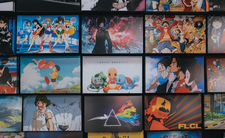Create cartoons and anime with OpenToonz
Toon Time

© Photo by Dex Ezekiel on Unsplash
OpenToonz is a professional animation tool for comic and manga artists.
Many readers associate the terms "manga" and "anime" respectively with Japanese comics and animated series, such as Dragon Ball or Pokemon, but today, manga and anime are global phenomena, and artists all over the world devote their attention and effort to the forms.
If you want to experiment with animation yourself, there is no need to stick to pen and paper. OpenToonz [1] is an open source tool that meets the highest animation standards. The program was partly developed in cooperation with famous animation companies such as Studio Ghibli [2], the creative minds behind classic anime films such as Princess Mononoke, Chihiro's Spirited Away, and How the Wind Rises.
OpenToonz is available in the package sources of most popular Linux distributions, so installing should be easy. To test the software with a sample scene, download the sample animation as a ZIP archive from the project page [3] (OpenToonz_sample.zip). You can view this sample on YouTube without installing OpenToonz [4]. Figure 1 shows OpenToonz with the official sample, which stars a dog named Dwanko.
[...]
Buy this article as PDF
(incl. VAT)
Buy Linux Magazine
Subscribe to our Linux Newsletters
Find Linux and Open Source Jobs
Subscribe to our ADMIN Newsletters
Support Our Work
Linux Magazine content is made possible with support from readers like you. Please consider contributing when you’ve found an article to be beneficial.

News
-
Mozilla Plans to AI-ify Firefox
With a new CEO in control, Mozilla is doubling down on a strategy of trust, all the while leaning into AI.
-
Gnome Says No to AI-Generated Extensions
If you're a developer wanting to create a new Gnome extension, you'd best set aside that AI code generator, because the extension team will have none of that.
-
Parrot OS Switches to KDE Plasma Desktop
Yet another distro is making the move to the KDE Plasma desktop.
-
TUXEDO Announces Gemini 17
TUXEDO Computers has released the fourth generation of its Gemini laptop with plenty of updates.
-
Two New Distros Adopt Enlightenment
MX Moksha and AV Linux 25 join ranks with Bodhi Linux and embrace the Enlightenment desktop.
-
Solus Linux 4.8 Removes Python 2
Solus Linux 4.8 has been released with the latest Linux kernel, updated desktops, and a key removal.
-
Zorin OS 18 Hits over a Million Downloads
If you doubt Linux isn't gaining popularity, you only have to look at Zorin OS's download numbers.
-
TUXEDO Computers Scraps Snapdragon X1E-Based Laptop
Due to issues with a Snapdragon CPU, TUXEDO Computers has cancelled its plans to release a laptop based on this elite hardware.
-
Debian Unleashes Debian Libre Live
Debian Libre Live keeps your machine free of proprietary software.
-
Valve Announces Pending Release of Steam Machine
Shout it to the heavens: Steam Machine, powered by Linux, is set to arrive in 2026.

